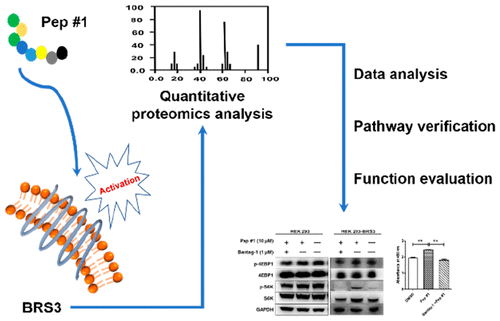当前位置:
X-MOL 学术
›
J. Proteome Res.
›
论文详情
Our official English website, www.x-mol.net, welcomes your
feedback! (Note: you will need to create a separate account there.)
Proteomics Analysis of Cellular BRS3 Receptor Activation Reveals Potential Mechanism for Signal Transduction and Cell Proliferation.
Journal of Proteome Research ( IF 3.8 ) Pub Date : 2020-02-24 , DOI: 10.1021/acs.jproteome.9b00760 Lijie Dong 1 , Baohui Zhang 1 , Lehao Wu 1 , Zhi Shang 1 , Sha Liu 1 , Xiaoteng Jiang 1 , Huiyu Wang 1 , Liuyin Fan 2 , Yan Zhang 3 , Hua Xiao 1
Journal of Proteome Research ( IF 3.8 ) Pub Date : 2020-02-24 , DOI: 10.1021/acs.jproteome.9b00760 Lijie Dong 1 , Baohui Zhang 1 , Lehao Wu 1 , Zhi Shang 1 , Sha Liu 1 , Xiaoteng Jiang 1 , Huiyu Wang 1 , Liuyin Fan 2 , Yan Zhang 3 , Hua Xiao 1
Affiliation

|
Bombesin-like receptor 3 (BRS3), an orphan G protein-coupled receptor (GPCR), plays important roles in our biological system while the exact mechanisms behind it are less known. To get insights of the biological effects upon BRS3 activation, we utilized quantitative proteomics approach to explore the dynamic protein profiling during the stimulation by its ligand. At different time points after stimulation with BRS3 surrogate agonist, the protein profiling in BRS3 overexpressed HEK 293 cells BRS3 (HEK 293-BRS3) was analyzed by nano-LC–MS/MS. In total, 1593 cellular proteins were confidently identified and quantified, including 146 proteins dysregulated at multiple time points and 319 proteins only altered at one time point. Data analysis indicated that BRS3 activation could regulate cell death, survival, and protein synthesis, particularly mRNA translation. Key signaling pathways were revealed for BRS3 signal transduction. In particular, 21 of our identified proteins are involved in the rapamycin (mTOR) signaling pathway. The promotion of mTOR was further confirmed through monitoring its indicative targets upon BRS3 activation. Upon the inhibition of mTOR by rapamycin, cell proliferation was dramatically reversed. Our proteomics data collectively demonstrate that BRS3 activation will lead to cascades of signal transduction and promote cell proliferation. The developed strategy might be utilized to discover the roles of other GPCRs and improve our understanding of their unknown functions.
中文翻译:

细胞BRS3受体激活的蛋白质组学分析揭示了信号转导和细胞增殖的潜在机制。
轰炸蛋白样受体3(BRS3),一种孤儿G蛋白偶联受体(GPCR),在我们的生物系统中起着重要作用,而其背后的确切机制尚不清楚。为了深入了解BRS3激活的生物学效应,我们利用定量蛋白质组学方法探索了其配体刺激过程中的动态蛋白质谱。在用BRS3替代激动剂刺激后的不同时间点,通过nano-LC-MS / MS分析了BRS3过表达的HEK 293细胞BRS3(HEK 293-BRS3)中的蛋白质谱。总共可以自信地鉴定和定量1593种细胞蛋白质,包括在多个时间点失调的146种蛋白质和仅在一个时间点改变的319种蛋白质。数据分析表明BRS3激活可以调节细胞死亡,存活和蛋白质合成,特别是mRNA翻译。揭示了BRS3信号转导的关键信号通路。特别是,我们鉴定出的蛋白质中有21种与雷帕霉素(mTOR)信号传导途径有关。通过在BRS3激活后监测其指示性靶点,进一步证实了mTOR的促进作用。雷帕霉素抑制mTOR后,细胞增殖急剧逆转。我们的蛋白质组学数据共同证明BRS3激活将导致信号转导的级联并促进细胞增殖。制定的策略可用于发现其他GPCR的作用,并增进我们对其未知功能的了解。通过在BRS3激活后监测其指示性靶点,进一步证实了mTOR的促进作用。雷帕霉素抑制mTOR后,细胞增殖急剧逆转。我们的蛋白质组学数据共同证明BRS3激活将导致信号转导的级联并促进细胞增殖。制定的策略可用于发现其他GPCR的作用,并增进我们对其未知功能的了解。通过在BRS3激活后监测其指示性靶点,进一步证实了mTOR的促进作用。雷帕霉素抑制mTOR后,细胞增殖急剧逆转。我们的蛋白质组学数据共同证明BRS3激活将导致信号转导的级联并促进细胞增殖。制定的策略可用于发现其他GPCR的作用,并增进我们对其未知功能的了解。
更新日期:2020-02-24
中文翻译:

细胞BRS3受体激活的蛋白质组学分析揭示了信号转导和细胞增殖的潜在机制。
轰炸蛋白样受体3(BRS3),一种孤儿G蛋白偶联受体(GPCR),在我们的生物系统中起着重要作用,而其背后的确切机制尚不清楚。为了深入了解BRS3激活的生物学效应,我们利用定量蛋白质组学方法探索了其配体刺激过程中的动态蛋白质谱。在用BRS3替代激动剂刺激后的不同时间点,通过nano-LC-MS / MS分析了BRS3过表达的HEK 293细胞BRS3(HEK 293-BRS3)中的蛋白质谱。总共可以自信地鉴定和定量1593种细胞蛋白质,包括在多个时间点失调的146种蛋白质和仅在一个时间点改变的319种蛋白质。数据分析表明BRS3激活可以调节细胞死亡,存活和蛋白质合成,特别是mRNA翻译。揭示了BRS3信号转导的关键信号通路。特别是,我们鉴定出的蛋白质中有21种与雷帕霉素(mTOR)信号传导途径有关。通过在BRS3激活后监测其指示性靶点,进一步证实了mTOR的促进作用。雷帕霉素抑制mTOR后,细胞增殖急剧逆转。我们的蛋白质组学数据共同证明BRS3激活将导致信号转导的级联并促进细胞增殖。制定的策略可用于发现其他GPCR的作用,并增进我们对其未知功能的了解。通过在BRS3激活后监测其指示性靶点,进一步证实了mTOR的促进作用。雷帕霉素抑制mTOR后,细胞增殖急剧逆转。我们的蛋白质组学数据共同证明BRS3激活将导致信号转导的级联并促进细胞增殖。制定的策略可用于发现其他GPCR的作用,并增进我们对其未知功能的了解。通过在BRS3激活后监测其指示性靶点,进一步证实了mTOR的促进作用。雷帕霉素抑制mTOR后,细胞增殖急剧逆转。我们的蛋白质组学数据共同证明BRS3激活将导致信号转导的级联并促进细胞增殖。制定的策略可用于发现其他GPCR的作用,并增进我们对其未知功能的了解。











































 京公网安备 11010802027423号
京公网安备 11010802027423号